Related Research Articles

Metra is the commuter rail system in the Chicago metropolitan area serving the city of Chicago and its surrounding suburbs via the Union Pacific Railroad, BNSF Railway, and other railroads. The system operates 242 stations on 11 rail lines. It is the fourth busiest commuter rail system in the United States by ridership and the largest and busiest commuter rail system outside the New York City metropolitan area. In 2022, the system had a ridership of 23,726,400, or about 113,300 per weekday as of the fourth quarter of 2022. The estimated busiest day for Metra ridership occurred on November 4, 2016—the day of the Chicago Cubs 2016 World Series victory rally.
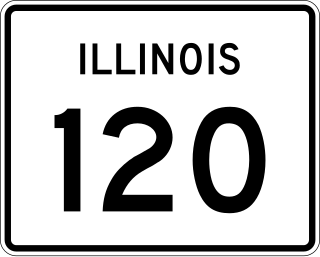
Illinois Route 120 (IL 120) is a major east–west state highway in northeastern Illinois. It runs from U.S. Route 14 near Woodstock to Illinois Route 131 in Waukegan. It travels a distance of 34.62 miles (55.72 km) and is one of the few roads that provides direct access from McHenry County to Interstate 94 in Lake County. Throughout its length, it shifts between two and four lanes as it passes through a setting that consists of open rural areas, as well as larger developments and heavy congestion.

The South Shore Line is an electrically powered interurban commuter rail line operated by the Northern Indiana Commuter Transportation District (NICTD) between Millennium Station in downtown Chicago and the South Bend International Airport in South Bend, Indiana, United States. The name refers to both the physical line and the service operated over that route. The line was built in 1901–1908 by predecessors of the Chicago South Shore and South Bend Railroad, which continues to operate freight service. Passenger operation was assumed by the NICTD in 1989. The South Shore Line is one of the last surviving interurban trains in the United States. In 2022, the system had a ridership of 1,406,400, or about 4,600 per weekday as of the fourth quarter of 2022.

The Union Pacific Northwest Line (UP-NW) is a commuter rail line provided by Metra and operated by the Union Pacific Railroad in Chicago, Illinois and its surrounding suburbs. While Metra does not refer to any of its lines by colors, the timetable accents for the Union Pacific Northwest Line are bright "Viking Yellow," honoring the Chicago & North Western Railway's Viking passenger train.

The BNSF Line is a Metra commuter rail line operated by the BNSF Railway in Chicago and its western suburbs, running from Chicago Union Station to Aurora, Illinois. In 2010, the BNSF Line continued to have the highest weekday ridership of the 11 Metra lines. While Metra does not refer to its lines by particular colors, the BNSF line's color on Metra timetables is "Cascade Green," in honor of the Burlington Northern Railroad.

The Milwaukee District North Line (MD-N) is a Metra commuter rail line in Chicago, Illinois and its northern suburbs, running from Union Station to Fox Lake. Although Metra does not refer to any of its lines by color, the timetable accents for the Milwaukee District North line are pale "Hiawatha Orange" in honor of the Milwaukee Road's Hiawatha passenger trains.

The Heritage Corridor (HC) is a Metra commuter rail line in Chicago, Illinois, and its southwestern suburbs, terminating in Joliet, Illinois. While Metra does not refer to its lines by colors, the Heritage Corridor appears on Metra timetables as "Alton Maroon," after the Alton Railroad, which ran trains on this route. The name Heritage Corridor refers to the Illinois and Michigan Canal Heritage Corridor. Established in 1984, it runs parallel to the line.

The Rock Island District (RI) is a Metra commuter rail line from Chicago, Illinois, southwest to Joliet. Metra does not refer to its lines by color, but the timetable accents for the Rock Island District line are "Rocket Red" in honor of the Chicago, Rock Island and Pacific Railroad's Rocket passenger trains.
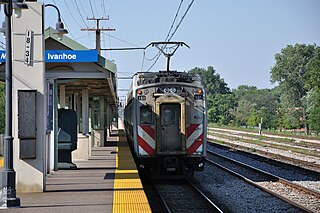
The Metra Electric District is an electrified commuter rail line owned and operated by Metra which connects Millennium Station, in downtown Chicago, with the city's southern suburbs. As of 2018, it is the fifth busiest of Metra's 11 lines, after the BNSF, UP-NW, UP-N, and UP-W Lines with nearly 7.7 million annual riders. While Metra does not explicitly refer to any of its lines by color, the timetable accents for the Metra Electric District are printed in bright "Panama orange" to reflect the line's origins with the Illinois Central Railroad (IC) and its Panama Limited passenger train. Apart from the spots where its tracks run parallel to other main lines, it is the only Metra line running entirely on dedicated passenger tracks, with no freight trains operating anywhere on the actual route itself. The line is the only one in the Metra system with more than one station in Downtown Chicago, and also has the highest number of stations (49) of any Metra line.

Joliet Union Station was a train station in Joliet, Illinois that served Amtrak long-distance and Metra commuter trains. It was replaced by the new Joliet Transportation Center in 2018, a train station that was constructed adjacent to the Union Station's location. Train service to Joliet Union Station permanently ceased in September 2014. The station is 37.0 miles (59.5 km) from Chicago Union Station on the Heritage Corridor, and 40.1 miles (64.5 km) from Chicago LaSalle St. Station on the Rock Island District.

Wilson is an 'L' station on the CTA's Red and Purple Lines, located at 4620 North Broadway in the Uptown neighborhood of Chicago, Illinois.
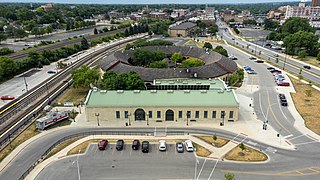
The Aurora Transportation Center is a station on Metra's BNSF Line in Aurora, Illinois. The station is 37.1 miles (59.7 km) from Union Station, the east end of the line. In Metra's zone-based fare system, Aurora is in zone H. As of 2018, Aurora is the 13th busiest of Metra's 236 non-downtown stations, with an average of 1,856 weekday boardings. There is a staffed station building. Just north of the station is the Hill Yard, a large coach yard used to store the Metra trains on the BNSF Line. Aurora is a stub-track terminal, which means the Metra tracks end here. Amtrak and BNSF freights use the two tracks east of the station.
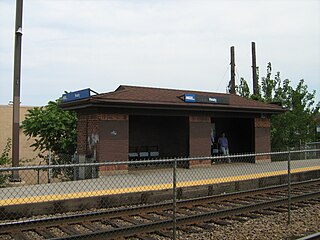
Healy is a station on Metra's Milwaukee District North Line in the Hermosa community area of Chicago, Illinois. The station is 6.4 miles (10.3 km) away from Chicago Union Station, the southern terminus of the line. In Metra's zone-based fare system, Healy is in zone B. As of 2018, Healy is the 140th busiest of Metra's 236 non-downtown stations, with an average of 323 weekday boardings. It is just south of the factories of Newly Weds Foods. The station is named after the Lyon & Healy Harps, Inc., a world-renowned harp manufacturer founded in Chicago in 1864 by George W. Lyon and Patrick J. Healy. Now headquartered on Ogden Avenue, the company was located near the station at 4014 W. Fullerton Ave. until 1914.

The Jefferson Park Transit Center is an intermodal passenger transport hub in the Jefferson Park neighborhood of Chicago, Illinois. It serves as a station for rail and also as a bus terminal. Jefferson Park Transit Center's railroad station is on Metra's Union Pacific Northwest Line, with the station located at 4963 North Milwaukee Avenue. Jefferson Park is 9.1 miles (14.6 km) away from Ogilvie Transportation Center in downtown Chicago, the inbound terminus of the Union Pacific Northwest Line. Under Metra's zone-based fare system, Jefferson Park is in zone B. As of 2018, Jefferson Park is the 97th busiest of Metra's 236 non-downtown stations, with an average of 510 weekday boardings.

Harvey is one of two Metra Electric commuter rail stations along the line's Main Branch in Harvey, Illinois. The station is located at Park Avenue and 154th Street, and is 20.0 miles (32.2 km) away from the northern terminus at Millennium Station. In Metra's zone-based fare system, Harvey is in zone D. As of 2018, Harvey is the 102nd busiest of Metra's 236 non-downtown stations, with an average of 471 weekday boardings.
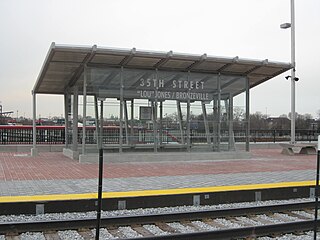
Jones/Bronzeville, also known as 35th Street, is a station on Metra's Rock Island District line. It is located in the Bronzeville neighborhood on the South Side of Chicago, Illinois. It was named in honor of Lovana Jones who was an Illinois State Representative in the Bronzeville neighborhood.
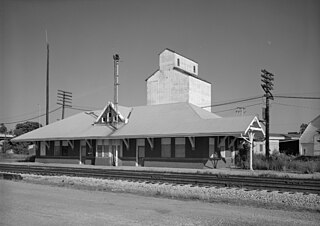
Morris station was a Chicago, Rock Island and Pacific Railway station in Morris, Illinois. Unlike many old stations, the depot is still standing on the south side of the track just west of Route 47. The tracks were built by the Rock Island Line in 1853. The single track line is now on the CSX New Rock Subdivision. Across the tracks is the former Illinois Terminal Railway station house, now used as a business. The station is considered for service on Amtrak's proposed Chicago—Moline—Iowa City line. There is speculation that Metra's Rock Island District will be extended to Morris.

Romeoville is a station on Metra's Heritage Corridor at the intersection of 135th Street and New Avenue in Romeoville, Illinois. As of 2018, Romeoville is the 170th busiest of Metra's 236 non-downtown stations, with an average of 148 weekday boardings. As of April 2022, Romeoville is currently the newest station in the Metra system.

DeKalb station is a former railway station in Downtown DeKalb, Illinois. It served passenger trains of the Chicago and North Western Railway (C&NW) along its main line between Chicago and Omaha. The station was designed by Charles Sumner Frost and Alfred Hoyt Granger in 1891 and closed for passenger service in 1971. The building still stands and is used by the Union Pacific Railroad for offices.
References
- ↑ The Official railway guide: North American freight service edition. Retrieved February 7, 2011
- ↑ Google (February 7, 2011). "Romeoville Station" (Map). Google Maps . Google. Retrieved February 7, 2011.
- ↑ Wronski, Richard (December 7, 2009). "Metra on track to rehab and rebuild dozens of stations". Chicago Tribune . Retrieved 2009-12-12.
- ↑ "Archived copy" (PDF). Archived from the original (PDF) on 2009-03-20. Retrieved 2009-01-10.
{{cite web}}: CS1 maint: archived copy as title (link) - ↑ "Chicago Suburbs News - Chicago Tribune".
- ↑ "Romeoville breaks ground on new Metra station | Metra". www.metrarail.com. Retrieved 2018-02-12.